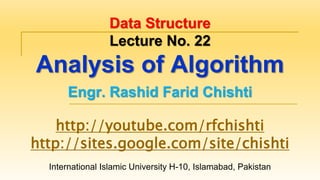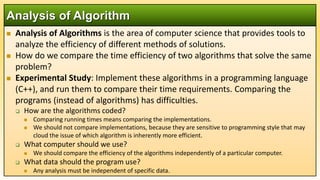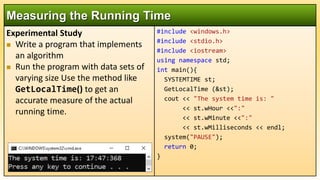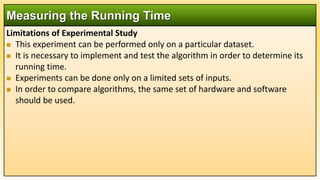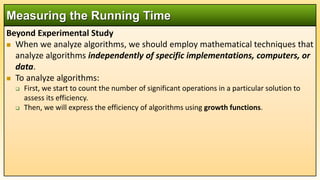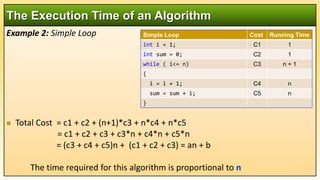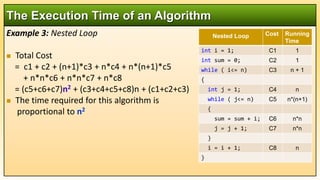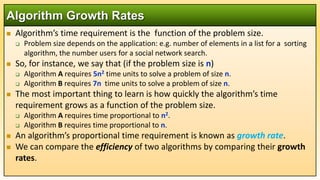Data Structures and Agorithm: DS 22 Analysis of Algorithm.pptx
- 1. International Islamic University H-10, Islamabad, Pakistan Data Structure Lecture No. 22 Analysis of Algorithm Engr. Rashid Farid Chishti http://youtube.com/rfchishti http://sites.google.com/site/chishti
- 2. An algorithm is a set of instructions to be followed to solve a problem. There can be more than one solution (more than one algorithm) to solve a given problem. An algorithm can be implemented using different programming languages on different platforms. An algorithm must be correct. It should correctly solve the problem. e.g. For sorting, this algorithm should work even if the input is already sorted, or it contains repeated elements. Once we have a correct algorithm for a problem, we have to determine the efficiency of that algorithm. Program: An Implementation of Algorithm in some programming language Data Structure: Organization of data needed to solve the problem Algorithm
- 3. There are two aspects of algorithmic performance: Time Instructions take time. How fast does the algorithm perform ? What affects its runtime ? Space Data structures take space (RAM) What kind of data structures can be used ? How does choice of data structure affect the runtime ? We will focus on time: How to estimate the time required for an algorithm ? How to reduce the time required ? Efficiency of an Algorithm
- 4. Analysis of Algorithms is the area of computer science that provides tools to analyze the efficiency of different methods of solutions. How do we compare the time efficiency of two algorithms that solve the same problem? Experimental Study: Implement these algorithms in a programming language (C++), and run them to compare their time requirements. Comparing the programs (instead of algorithms) has difficulties. How are the algorithms coded? Comparing running times means comparing the implementations. We should not compare implementations, because they are sensitive to programming style that may cloud the issue of which algorithm is inherently more efficient. What computer should we use? We should compare the efficiency of the algorithms independently of a particular computer. What data should the program use? Any analysis must be independent of specific data. Analysis of Algorithm
- 5. Experimental Study Write a program that implements an algorithm Run the program with data sets of varying size Use the method like GetLocalTime() to get an accurate measure of the actual running time. Measuring the Running Time #include <windows.h> #include <stdio.h> #include <iostream> using namespace std; int main(){ SYSTEMTIME st; GetLocalTime (&st); cout << "The system time is: " << st.wHour <<":" << st.wMinute <<":" << st.wMilliseconds << endl; system("PAUSE"); return 0; }
- 6. #include <windows.h> #include <stdio.h> #include <iostream> using namespace std; long double factorial(long double n){ if (n < 0) // if n is negative exit(-1); // close the program long double f = 1; while (n > 1) f *= n--; return f; } Measuring the Running Time int main(){ LARGE_INTEGER t1, t2, t3; long double n, answer; cout << "Enter a positive integer: ";// 170 cin >> n; QueryPerformanceCounter(&t1); answer = factorial(n); QueryPerformanceCounter(&t2); t3.QuadPart = t2.QuadPart - t1.QuadPart; cout << n << "! = " << answer << endl; cout << "Time taken = " << t3.QuadPart <<" nano seconds" << endl; system("PAUSE"); return 0; }
- 7. Limitations of Experimental Study This experiment can be performed only on a particular dataset. It is necessary to implement and test the algorithm in order to determine its running time. Experiments can be done only on a limited sets of inputs. In order to compare algorithms, the same set of hardware and software should be used. Measuring the Running Time
- 8. Beyond Experimental Study When we analyze algorithms, we should employ mathematical techniques that analyze algorithms independently of specific implementations, computers, or data. To analyze algorithms: First, we start to count the number of significant operations in a particular solution to assess its efficiency. Then, we will express the efficiency of algorithms using growth functions. Measuring the Running Time
- 9. Each operation in an algorithm (or a program) has a cost. Each operation takes a certain of time. count = count + 1; // take a certain amount of time, but it is constant A sequence of operations: count = count + 1; Cost: c1 sum = sum + count; Cost: c2 Total Cost = c1 + c2 Example 1: Simple If-Statement Total Cost = c1 + c2+max(c3,c4) The Execution Time of an Algorithm Simple if Statement Cost Running Time int abs_value; C1 1 if ( n < 0 ) C2 1 abs_value = -n; C3 1 else abs_value = n; C4 1
- 10. Example 2: Simple Loop Total Cost = c1 + c2 + (n+1)*c3 + n*c4 + n*c5 = c1 + c2 + c3 + c3*n + c4*n + c5*n = (c3 + c4 + c5)n + (c1 + c2 + c3) = an + b The time required for this algorithm is proportional to n The Execution Time of an Algorithm Simple Loop Cost Running Time int i = 1; C1 1 int sum = 0; C2 1 while ( i<= n) C3 n + 1 { i = i + 1; C4 n sum = sum + i; C5 n }
- 11. Example 3: Nested Loop Total Cost = c1 + c2 + (n+1)*c3 + n*c4 + n*(n+1)*c5 + n*n*c6 + n*n*c7 + n*c8 = (c5+c6+c7)n2 + (c3+c4+c5+c8)n + (c1+c2+c3) The time required for this algorithm is proportional to n2 The Execution Time of an Algorithm Nested Loop Cost Running Time int i = 1; C1 1 int sum = 0; C2 1 while ( i<= n) C3 n + 1 { int j = 1; C4 n while ( j<= n) C5 n*(n+1) { sum = sum + i; C6 n*n j = j + 1; C7 n*n } i = i + 1; C8 n }
- 12. Loops: The running time of a loop is at most the running time of the statements inside of that loop times the number of iterations. Nested Loops: Running time of a nested loop containing a statement in the inner most loop is the running time of statement multiplied by the product of the sized of all loops. Consecutive Statements: Just add the running times of those consecutive statements. If Else: Never more than the running time of the test plus the larger of running times of S1 and S2. General Rules for Estimation
- 13. Algorithm’s time requirement is the function of the problem size. Problem size depends on the application: e.g. number of elements in a list for a sorting algorithm, the number users for a social network search. So, for instance, we say that (if the problem size is n) Algorithm A requires 5n2 time units to solve a problem of size n. Algorithm B requires 7n time units to solve a problem of size n. The most important thing to learn is how quickly the algorithm’s time requirement grows as a function of the problem size. Algorithm A requires time proportional to n2. Algorithm B requires time proportional to n. An algorithm’s proportional time requirement is known as growth rate. We can compare the efficiency of two algorithms by comparing their growth rates. Algorithm Growth Rates
- 14. Algorithm Growth Rates Graph of time requirements as a function of the problem size n Common Growth Rates Function Growth Rate Name c Constant log2 N Logarithmic log2 N Log-squared N Linear N log2 N Log-linear N2 Quadratic N3 Cubic 2N Exponential 2
- 15. Running Time for Small Inputs Running time Input size (x = n) x3 2x x2 log2(x)
- 16. Running Time for Large Inputs Running time Input size (x = n) x.log2(x) x x2 2x x3
- 17. Searching a number from array, (Best Case) The number found is at index 0 (Worst Case) The Number was Not Fount or the number found is at index N-1, Where N is the size of an array. (Average Case) The number found is at index between 1 and N-1 Best, Average and Worst Case 0 1 2 3 4 5 6 A B C D E F G Running Time (ms) - - - - - - - - - - - - - - - - - - - - - - - - - - - - - - - - - - Worst Case - - - - - - - - - - - - - - - - - - - - - - - - - - - - - - - - - - Best Case }Average Case dataset
- 18. Asymptotic notation of an algorithm is a mathematical representation of its complexity. There are three types of Asymptotic Notations... Big - O (O) Big - Omega (Ω) Big - Theta (θ) Big - Oh Notation (O): Big Oh notation is used to define the upper bound of an algorithm in terms of Time Complexity. It provides us with an asymptotic upper bound. That means Big - Oh notation always indicates the maximum time required by an algorithm for all input values. That means Big Oh notation describes the worst case of an algorithm time complexity. Asymptotic Notations
- 19. f(n) is your algorithm runtime, and g(n) is an arbitrary time complexity. you are trying to relate to your algorithm. f(n) is O(g(n)), if for some real constants c (c > 0) and number n0 , f(n) ≤ c g(n) for every input size n (n > n0). O(g(n)) = { f(n): there exist positive constants c and n0 such that 0 ≤ f(n) ≤ cg(n) for all n ≥ n0 } f(n) = O(g(n)) means f(n) grows slower than or equal to c g(n) If an Algo A requires time proportional to n2, it is O(n2). If an Algo A requires time proportional to n, it is O(n). Big - Oh Notation (O)
- 20. Big - Oh Notation (O) f(n) = 7n2 + 2n + 4 f(n) = 5n2 + 6n + 4 g(n) = 8n2 n0 = 4
- 21. To Simply the analysis of running time by getting the rid of details which may be affected by specific implementation hardware. Capturing the Essence: how the running time of an algorithm increases with the size of the input in the limit. Two Basic Rules: Drop all lower order terms Drop all constants Big - Oh Notation (O) f(n) = 5n2 + 6n + 10 = 5n2 + 6n + 10 = 5n2 + 10 = 5n2 + 10 = n2 f(n) = 7n2 + 2n + 4 = 7n2 + 2n + 4 = 7n2 + 4 = 7n2 + 4 = n2
- 22. If an algorithm requires f(n) = n2-3n+10 seconds to solve a problem size n. If constants k and n0 exist such that k*n2 >= n2-3n+10 for all n >= n0 . the algorithm is order n2 (In fact, k is 2 and n0 is 2) 2*n2 >= n2-3n+10 for all n >= 2 . Thus, the algorithm requires no more than k*n2 time units for n >= n0 , So it is O(n2) Big - Oh Notation (O)
- 23. Big - Oh Notation (O) n0 = 2 K=2
- 24. Big - Oh Notation (O) Show 2x + 17 is O(2x) 2x + 17 ≤ 2x + 2x = 2*2x for x > 5 Hence k = 2 and n0 = 5 2*2x n0 = 5
- 25. Big Omega notation is used to define the lower bound of an algorithm in terms of Time Complexity. That means Big-Omega notation always indicates the minimum time required by an algorithm for all input values. That means Big-Omega notation describes the best case of an algorithm time complexity. It provides us with an asymptotic lower bound. f(n) is Ω(g(n)), if for some real constants c (c > 0) and number n0 (n0 > 0), f(n) ≥ c g(n) for every input size n (n > n0) f(n) = Ω(g(n)) means f(n) grows faster than or equal to g(n) Big - Omega Notation (Ω)
- 26. Big - Theta notation is used to define the average bound of an algorithm in terms of Time Complexity and denote the asymptotically tight bound (Sandwich between best case and worst case) That means Big - Theta notation always indicates the average time required by an algorithm for all input values. That means Big - Theta notation describes the average case of an algorithm time complexity. function f(n) as time complexity of an algorithm and g(n) is the most significant term. If C1 g(n) ≤ f(n) ≤ C2 g(n) for all n ≥ n0 , C1 > 0, C2 > 0 and n0 ≥ 1 Then we can represent f(n) as θ(g(n)). Big - Theta Notation (θ) Average Worst Best } }
- 27. Big - Theta Notation (θ) g(n) = 8n2 g(n) = 7n2 Show f(n) = 7n2 + 1 is 𝚹(n2) You need to show f(n) is O(n2) and f(n) is Ω(n2) f(n) is O(n2) because 7n2 + 1 ≤ 7n2 + n2 ∀ n ≥ 1 k1 = 8 n0 = 1 f(n) is Ω (n2) because 7n2 + 1 ≥ 7n2 ∀n ≥ 0 k2 = 7 n0 = 0 Pick the largest n0 to satisfy both conditions naturally k1 = 8, k2 = 7, n0 = 1 k1 = 8 n0 = 1 n0 = 0
- 28. Common Asymptotic Notations Complexity Terminology O (n!) Factorial O (2n), n>1 Exponential O (nb) Polynomial O (n2) Quadratic O (n log2 n) Linearithmic O (n) Linear O (log2 n) Logarithmic O (1) Constant Complexity Dataset Size (n) Running Time (sec) 2 2
- 30. Complexity Function: F(n) = C1*1 + C2*1 + Max(C3,C4)*1 = (C1+C2+C3)1 = 1 (a fixed value) So algorithm complexity is O(1) Running Time Analysis Example 1 Simple if Statement Cost Running Time int abs_value; C1 1 if ( n < 0 ) C2 1 abs_value = -n; C3 1 else abs_value = n; C4 1
- 31. Complexity Function: F(n) = C1 + C2 + (n+1)*C3 + n*C4 + n*C5 = (C3+C4+C5)*n + (C1+C2+C3) = an+b = n So algorithm complexity is O(n) Running Time Analysis Example 2 Simple Loop Cost Running Time int i = 1; C1 1 int sum = 0; C2 1 while ( i<= n) C3 n + 1 { i = i +1; C4 n sum = sum +1; C5 n }
- 32. Complexity Function: F(n) = c1 + c2 + (n+1)*c3 + n*c4 + n*(n+1)c5 + n*n*c6 + n*n*c7 + n*c8 = (c5+c6+c7)*n2 + (c3+c4+c5+c8)*n + (c1+c2+c3) = a*n2 + b*n + c So algorithm complexity is O(n2) Running Time Analysis Example 3 Nested Loop Cost Running Time int i = 1; C1 1 int sum = 0; C2 1 while ( i<= n) C3 n + 1 { int j = 1; C4 n while ( j<= n) C5 n*(n+1) { sum = sum +1; C6 n*n j = j + 1; C7 n*n } i = i + 1; C8 n }
- 33. Some mathematical equalities are: Some Mathematical Facts 2 2 ) 1 ( * ... 2 1 2 1 n n n n i n i 3 6 ) 1 2 ( * ) 1 ( * ... 4 1 3 1 2 2 n n n n n i n i 1 2 2 ... 2 1 0 2 1 0 1 n i n n i
- 34. Complexity Function: T(n) = c1*(n+1) + c2*( ) + c3* ( ) + c4*( ) = a*n3 + b*n2 + c*n + d So, the growth-rate function for this algorithm is O(n3) Running Time Analysis Example 4 Nested Loop Cost Running Time for (int i=1; i<=n; i++) C1 n+1 for (int j=1; j<=i; j++) C2 for (int k=1; k<=j; k++) C3 x = x+1; C4 n j j 1 ) 1 ( n j j k k 1 1 ) 1 ( n j j k k 1 1 n j j 1 ) 1 ( n j j k k 1 1 ) 1 ( n j j k k 1 1
Editor's Notes
- #7: #include <windows.h> #include <stdio.h> #include <iostream> using namespace std; long double factorial(long double n){ if (n < 0) // if n is negative exit(-1); // close the program long double f = 1; while (n > 1) f *= n--; //1st f=f*n then n decrements return f; } int main(){ LARGE_INTEGER StartingTime, EndingTime, ElapsedNanoseconds; long double n, answer; cout << "Enter a positive integer: "; // e.g. 170 cin >> n; QueryPerformanceCounter(&StartingTime); answer = factorial(n); QueryPerformanceCounter(&EndingTime); ElapsedNanoseconds.QuadPart = EndingTime.QuadPart - StartingTime.QuadPart; cout << n << "! = " << answer << endl; cout << "Time taken = " << ElapsedNanoseconds.QuadPart <<" nano seconds" << endl; system("PAUSE"); return 0; }
